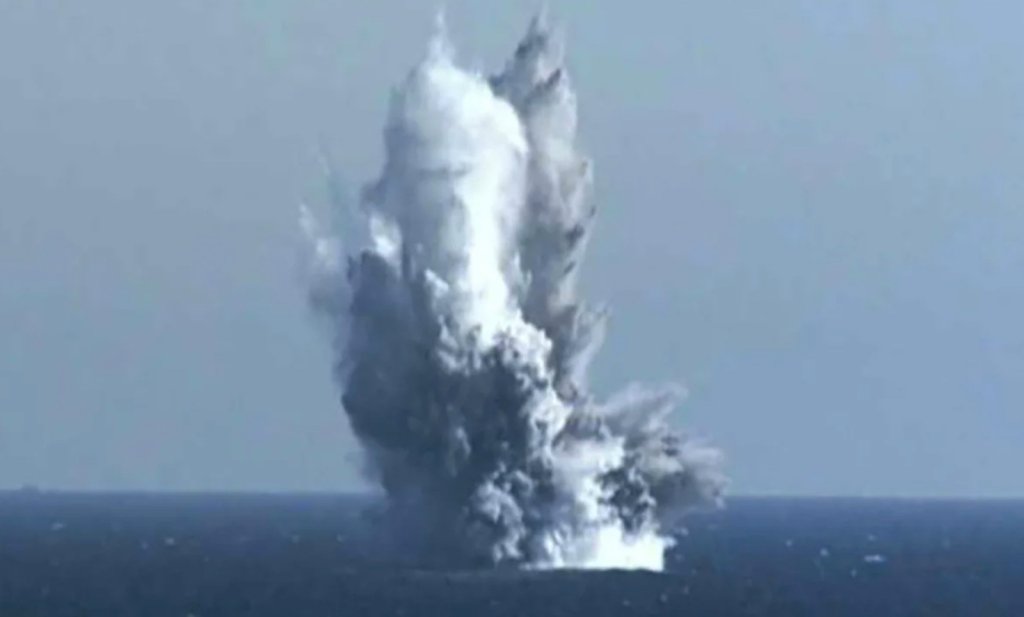Aside from its nuclear arsenal, there’s not a lot of boasting North Korea can do about its military. We can have faith that North Korea will do it anyway. Yet, its latest weapon appears to be something worth bragging about. It’s an underwater drone, capable of generating what the Hermit Kingdom calls a “radioactive tsunami.”
According to North Korea’s state media, the Korean Central News Agency (KCNA), the new weapon is capable of destroying naval strike groups and would be used to target enemy ports. Analysts aren’t so sure, considering it’s only been a matter of days since the U.S. announced it would deploy a carrier strike group near the Korean Peninsula.
For North Korea watchers, a sudden response to a perceived provocation might sound familiar because that’s been Pyongyang’s main play for the past year. Making tit-for-tat threats after U.S. or South Korean military announcements has been the first move to come from the North Korean playbook, often beginning with joint American-South Korean military exercises meant to simulate the response to a North Korean invasion, something that always draws ire from the North.
According to KCNA, the new submersible weapon can either be deployed from the coast or towed using surface ships. The primary news service of the Democratic People’s Republic of Korea says the weapon works to “stealthily infiltrate into operational waters and make a super-scale radioactive tsunami through an underwater explosion.”
Hours after North Korea made its radioactive tsunami announcement, South Korean President Yoon Suk Yeol attended a remembrance ceremony in the South, honoring 55 South Korean troops killed in altercations, clashes, and attacks from North Korea along the two countries’ western sea borders in recent years. There, President Yoon declared he would make North Korea pay for “reckless provocations” it made against the South.
The new weapon test was part of a three-day exercise by DPRK forces that simulated nuclear attacks on the U.S. and its South Korean ally, on unspecified targets. The exercise included the launch of North Korean cruise missiles. The nuclear drills were intended to alert the U.S. and South Korean militaries that they were courting a “nuclear crisis” with the North with their “intentional, persistent and provocative war drills.”
North Korean leader Kim Jong Un said he would force North Korea’s enemies to “plunge into despair.” He called on the Korean People’s Army to be prepared to launch a nuclear attack as a deterrent to war. KCNA also claimed that 800,000 North Koreans volunteered to join the country’s already massive military force to fight the United States.

The 11-day joint American and South Korean exercises that apparently provoked the North Korean nuclear drills are the largest the two countries have employed in years. The carrier strike group on its way to Korea will be participating in a series of naval drills related to the exercises. There will also be a five-day component of the exercises involving both countries’ air forces, which will incorporate live fire drills, air-to-air targeting, and air-to-ground missions.
North Korea’s new weapon is called “Haeil,” meaning “tidal wave.” Kim Jong Un was featured in the Korean Workers Party’s official newspaper Rodong Sinmun sitting next to what is presumed to be the drone, which looked more like a torpedo than a submarine. The paper also featured photos of the underwater explosion caused by the weapons test.
The drone apparently traveled underwater for some 60 hours, according to official sources inside the DPRK, detonating at a target replicating an enemy port. Although the reports are impossible to verify, the North claims it has conducted more than 50 tests of the weapon since 2012 and is capable of hitting all South Korean ports.

